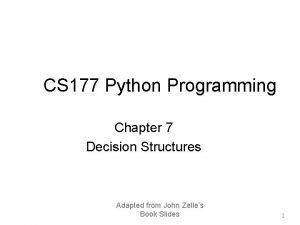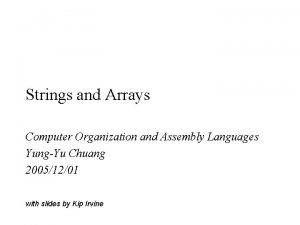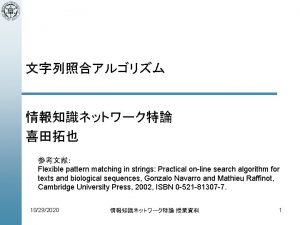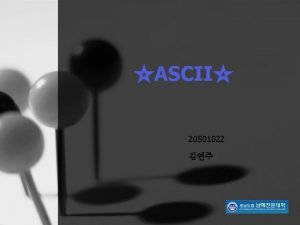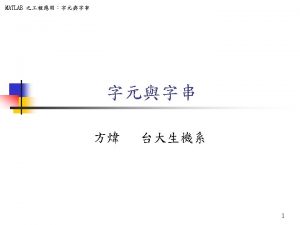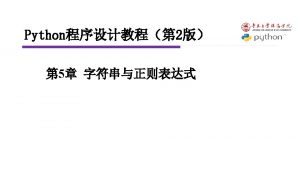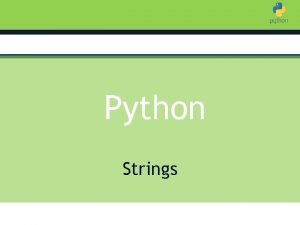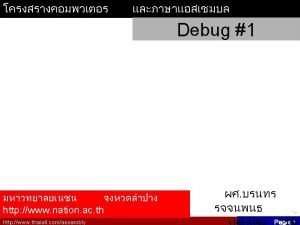Decisions in Python Comparing Strings ASCII History Comparing










- Slides: 10

Decisions in Python Comparing Strings – ASCII History

Comparing strings • Comparing numbers is easy, how do you compare strings? • Remember that everything inside the computer is a number – yes, everything! • So every character on the keyboard (and more) are represented as a number inside • Does that mean you have to memorize a lot of numbers to compare strings? No!

Comparing strings • If the operator is ==, then the strings have to be exactly identical – same spacing, same case, everything has to be the same to give a True (!= gives a False then) • If the operator is one of the other relational operators, how do you tell if one string is less than another? greater than? By using their ASCII codes!

ASCII • American Standard Code for Information Interchange • Early computer manufacturers each had their own code for characters • Users didn’t care as long as it worked, until they wanted to share / trade / sell information with someone who had a different brand of computer

ASCII • Some small companies made a living translating data from one company’s code to another • The computing community decided they needed a standard code for characters for all computers • Having one helps the Internet send messages between dissimilar computers • Other codes were considered but ASCII was the winner in the mid 1960’s • ASCII has 256 codes, each character takes up 1 byte

ASCII • ASCII is designed so that the alphabetic characters are in numeric order also. So ‘A’ < ‘B’ < ‘C’ < ‘D’ < … < ‘Z’ • Other characters: the lower case alphabetic characters are also in numeric order ‘a’ < ‘b’ < ‘c’ < ‘d’ < … < ‘z’ • The lower case letters come after the upper case letters in ASCII – an arbitrary decision

ASCII • What about digits? ‘ 0’, ‘ 1’, ‘ 2’, ‘ 3’, …? • They have codes also. ASCII is designed so those digits are also in numeric order ‘ 0’ < ‘ 1’ < ‘ 2’ < ‘ 3’ < … < ‘ 9’ • The codes for the digits are less than the upper case letters – an arbitrary decision • Just one more! ‘ ‘ = 1 space, is the lowest printable character, lower than all the other characters discussed

ASCII • • • Summary of the order you should know First comes the space character Then the digits ‘ 0’ ‘ 1’ ‘ 2’ ‘ 3’ ‘ 4’ ‘ 5’ ‘ 6’ ‘ 7’ ‘ 8’ ‘ 9’ Then the upper case ‘A’, ‘B’, ‘C’, ‘D’, … ‘Z’ Then the lower case ‘a’, ‘b’, ‘c’, ‘d’, …, ‘z’ There are other characters in the code – control codes, punctuation, etc. you do NOT have to know any of those.

Unicode • For a while ASCII’s 256 codes was sufficient. It contained the English (Roman) alphabet, digits and some pnc. • What about other countries / languages? • Eventually it was decided that a code that could represent more languages’ symbols had to be created. • Unicode came about in the 90’s – first 256 characters are the ASCII code • Each character takes up 2 bytes (or more!) so Unicode has at least 65 thousand character codes

What does Unicode mean to me? • It takes up more room than a plain ASCII text file, which means more room on your HD, more time uploading and downloading • As a programmer, you may run into “wide characters” or “fat characters” which will require different libraries / methods to handle • If you get documents in foreign languages, you will be better able to get them translated correctly (Unicode does not do translation!)
 String ascii python
String ascii python Decisions decisions decisions poster
Decisions decisions decisions poster Screening decisions and preference decisions
Screening decisions and preference decisions Multi way decisions in python
Multi way decisions in python Multi way decisions in python
Multi way decisions in python Decision structures in python
Decision structures in python Array of strings assembly
Array of strings assembly Import java.util.string
Import java.util.string Elastic strings and springs
Elastic strings and springs Flexible pattern matching in strings
Flexible pattern matching in strings Rate of energy transfer by sinusoidal waves on strings
Rate of energy transfer by sinusoidal waves on strings





